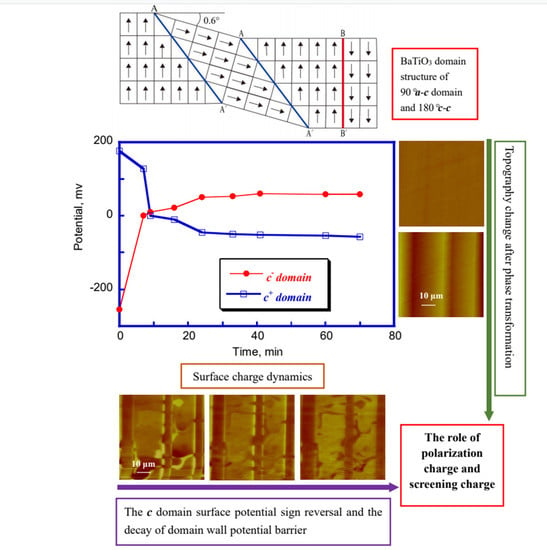Phase Transition Effect on Ferroelectric Domain Surface Charge Dynamics in BaTiO3 Single Crystal
Abstract
:1. Introduction
2. Materials and Methods
3. Results and Discussion
4. Conclusions
Author Contributions
Funding
Institutional Review Board Statement
Informed Consent Statement
Data Availability Statement
Conflicts of Interest
References
- Naber, R.C.G.; Asadi, K.; Blom, P.W.M.; De Leeuw, D.M.; De Boer, B. Organic Nonvolatile Memory Devices Based on Ferroelectricity. Adv. Mater. 2010, 22, 933–945. [Google Scholar] [CrossRef] [Green Version]
- Mikolajick, T.; Slesazeck, S.; Mulaosmanovic, H.; Park, M.H.; Fichtner, S.; Lomenzo, P.D.; Hoffmann, M.; Schroeder, U. Next generation ferroelectric materials for semiconductor process integration and their applications. J. Appl. Phys. 2021, 129, 100901. [Google Scholar] [CrossRef]
- Park, B.H.; Kang, B.S.; Bu, S.D.; Noh, T.W.; Lee, J.; Jo, W. Lanthanum-substituted bismuth titanate for use in non-volatile memories. Nat. Cell Biol. 1999, 401, 682–684. [Google Scholar] [CrossRef]
- Martin, L.W.; Rappe, A.M. Thin-film ferroelectric materials and their applications. Nat. Rev. Mater. 2017, 2, 16087. [Google Scholar] [CrossRef] [Green Version]
- Muralt, P. Ferroelectric thin films for micro-sensors and actuators: A review. J. Micromech. Microeng. 2000, 10, 136–146. [Google Scholar] [CrossRef]
- Whatmore, R.W.; Patel, A.; Shorrocks, N.M.; Ainger, F.W. Ferroelectric materials for thermal ir sensors state-of-the-art and perspectives. Ferroelectrics 1990, 104, 269–283. [Google Scholar] [CrossRef]
- Rogalski, A. History of infrared detectors. Opto-Electron. Rev. 2012, 20, 279–308. [Google Scholar] [CrossRef]
- Lines, M.E.; Glass, A.M. Principles and Applications of Ferroelectrics and Related Materials; Oxford University Press: Oxford, UK, 2001; pp. 125–163. [Google Scholar]
- Johnson, C.J. Some dielectric and electro-optic properties of batio3 single crystals. Appl. Phys. Lett. 1965, 7, 221. [Google Scholar] [CrossRef]
- Kalinin, S.V.; Bonnell, D.A.; Alvarez, T.; Lei, X.; Hu, Z.; Ferris, J.H.; Zhang, Q.; Dunn, S. Atomic Polarization and Local Re-activity on Ferroelectric Surfaces: A New Route toward Complex Nanostructures. Nano Lett. 2002, 2, 589–593. [Google Scholar] [CrossRef]
- Nelson, C.T.; Gao, P.; Jokisaari, J.R.; Heikes, C.; Adamo, C.; Melville, A.; Baek, S.H.; Folkman, C.M.; Winchester, B.; Gu, Y.; et al. Domain Dynamics during Ferroelectric Switching. Science 2011, 334, 968–971. [Google Scholar] [CrossRef] [Green Version]
- Balke, N.; Jesse, S.; Li, Q.; Maksymovych, P.; Okatan, M.; Strelcov, E.; Tselev, A.; Kalinin, S.V. Current and surface charge modified hysteresis loops in ferroelectric thin films. J. Appl. Phys. 2015, 118, 072013. [Google Scholar] [CrossRef]
- He, D.; Xing, X.; Qiao, L.; Volinsky, A.A. Temperature change effect on BaTiO3 single crystal surface potential around domain walls. Appl. Surf. Sci. 2014, 311, 837–841. [Google Scholar] [CrossRef]
- Yuan, G.; Chen, J.; Xia, H.; Liu, J.; Yin, J.; Liu, Z. Ferroelectric domain evolution with temperature in BaTiO3 film on (001) SrTiO3 substrate. Appl. Phys. Lett. 2013, 103, 62903. [Google Scholar] [CrossRef]
- Everhardt, A.S.; Denneulin, T.; Grünebohm, A.; Shao, Y.-T.; Ondrejkovic, P.; Zhou, S.; Domingo, N.; Catalan, G.; Hlinka, J.; Zuo, J.-M.; et al. Temperature-independent giant dielectric response in transitional BaTiO3 thin films. Appl. Phys. Rev. 2020, 7, 011402. [Google Scholar] [CrossRef] [Green Version]
- Su, Y.; Landis, C.M. Continuum thermodynamics of ferroelectric domain evolution: Theory, finite element implementation, and application to domain wall pinning. J. Mech. Phys. Solids 2007, 55, 280–305. [Google Scholar] [CrossRef]
- Liu, S.; Zheng, F.; Koocher, N.Z.; Takenaka, H.; Wang, F.; Rappe, A.M. Ferroelectric Domain Wall Induced Band Gap Reduction and Charge Separation in Organometal Halide Perovskites. J. Phys. Chem. Lett. 2015, 6, 693–699. [Google Scholar] [CrossRef]
- Zheng, T.; Wu, J.G. Perovskite BiFeO3-BaTiO3 ferroelectrics: Engineering property by domain evolution and thermal depo-larization modification. Adv. Electron. Mater. 2020, 6, 2000079. [Google Scholar] [CrossRef]
- Kalinin, S.V.; Sumpter, B.G.; Archibald, R.K. Big-deep-smart data in imaging for guiding materials design. Nat. Mater. 2015, 14, 973–980. [Google Scholar] [CrossRef] [PubMed]
- Kim, Y.; Han, H.; Lee, W.; Baik, S.; Hesse, D.; Alexe, M. Non-Kolmogorov−Avrami−Ishibashi Switching Dynamics in Na-noscale Ferroelectric Capacitors. Nano Lett. 2010, 10, 1266–1270. [Google Scholar] [CrossRef]
- Matsuura, K.; Cho, Y.; Ramesh, R. Observation of domain walls in PbZr0.2Ti0.8O3 thin film using scanning non-linear dielectric microscopy. Appl. Phys. Lett. 2003, 83, 2650. [Google Scholar] [CrossRef]
- Gruverman, A.; Alexe, M.; Meier, D. Piezoresponse force microscopy and nanoferroic phenomena. Nat. Commun. 2019, 10, 1661. [Google Scholar] [CrossRef] [Green Version]
- Liu, Y.; Yu, B.X.; Liu, Z.W.; Beck, D.; Zeng, K.Y. High-Speed Piezoresponse Force Microscopy and Machine Learning Ap-proaches for Dynamic Domain Growth in Ferroelectric Materials. ACS Appl. Mater. Interfaces 2020, 12, 9944–9952. [Google Scholar] [CrossRef] [PubMed]
- Kwon, O.; Seol, D.; Qiao, H.; Kim, Y. Recent Progress in the Nanoscale Evaluation of Piezoelectric and Ferroelectric Properties via Scanning Probe Microscopy. Adv. Sci. 2020, 7, 1901391. [Google Scholar] [CrossRef]
- Lilienblum, M.; Soergel, E. Anomalous domain inversion in LiNbO3 single crystals investigated by scanning probe microscopy. J. Appl. Phys. 2011, 110, 052018. [Google Scholar] [CrossRef] [Green Version]
- Li, T.; Zeng, K. Probing of Local Multifield Coupling Phenomena of Advanced Materials by Scanning Probe Microscopy Techniques. Adv. Mater. 2018, 30, e1803064. [Google Scholar] [CrossRef]
- Kalinin, S.V.; Jesse, S.; Tselev, A.; Baddorf, A.P.; Balke, N. The Role of Electrochemical Phenomena in Scanning Probe Microscopy of Ferroelectric Thin Films. ACS Nano 2015, 5, 5683–5691. [Google Scholar] [CrossRef]
- He, D.Y.; Qiao, L.J.; Volinsky, A.A. Humidity effect on BaTiO3 c-domain surface potential inversion induced by electric field. J. Appl. Phys. 2011, 110, 74104. [Google Scholar] [CrossRef]
- Liu, X.Y.; Kitamura, K.J. Surface potential imaging of nanoscale LiNbO3 domains investigated by electrostatic force microscopy. Appl. Phys. Lett. 2006, 89, 132905. [Google Scholar] [CrossRef]
- Lei, S.; Eliseev, E.; Morozovska, A.N.; Haislmaier, R.C.; Lummen, T.T.A.; Cao, W.; Kalinin, S.; Gopalan, V. Origin of piezoelectric response under a biased scanning probe microscopy tip across a 180 ferroelectric domain wall. Phys. Rev. B 2012, 86, 134115. [Google Scholar] [CrossRef] [Green Version]
- Kelley, K.P.; Ren, Y.; Morozovska, A.N.; Eliseev, E.A.; Ehara, Y.; Funakubo, H.; Giamarchi, T.; Balke, N.; Vasudevan, R.K.; Cao, Y.; et al. Dynamic Manipulation in Piezoresponse Force Microscopy: Creating Nonequilibrium Phases with Large Electromechanical Response. ACS Nano 2020, 14, 10569–10577. [Google Scholar] [CrossRef]
- Sakayori, K.; Matsui, Y.; Abe, H.; Nakamura, E.; Kenmoku, M.; Hara, T.; Ishikawa, D.; Kokubu, A.; Hirota, K.; Ikeda, T. Curie temperature of BaTiO3. Jpn. J. Appl. Phys. 1995, 34, 5443–5445. [Google Scholar] [CrossRef]
- Schoenherr, P.; Shapovalov, K.; Schaab, J.; Yan, Z.; Bourret, E.D.; Hentschel, M.; Stengel, M.; Fiebig, M.; Cano, A.; Meier, D. Observation of Uncompensated Bound Charges at Improper Ferroelectric Domain Walls. Nano Lett. 2019, 19, 1659–1664. [Google Scholar] [CrossRef] [PubMed]
- Li, X.; Wang, B.; Zhang, T.-Y.; Su, Y. Water Adsorption and Dissociation on BaTiO3 Single-Crystal Surfaces. J. Phys. Chem. C 2014, 118, 15910–15918. [Google Scholar] [CrossRef]
- Yamada, T.; Ito, D.; Sluka, T.; Sakata, O.; Tanaka, H.; Funakubo, H.; Namazu, T.; Wakiya, N.; Yoshino, M.; Nagasaki, T.; et al. Charge screening strategy for domain pattern control in nano-scale ferroelectric systems. Sci. Rep. 2017, 7, 5236. [Google Scholar] [CrossRef]
- Copie, O.; Chevalier, N.; Le Rhun, G.; Rountree, C.L.; Martinotti, D.; Gonzalez, S.; Mathieu, C.; Renault, O.; Barrett, N. Adsorbate Screening of Surface Charge of Microscopic Ferroelectric Domains in Sol–Gel PbZr0.2Ti0.8O3 Thin Films. ACS Appl. Mater. Interfaces 2017, 9, 29311–29317. [Google Scholar] [CrossRef] [Green Version]
- Nataf, G.F.; Guennou, M.; Gregg, J.M.; Meier, D.; Hlinka, J.; Salje, E.K.H.; Kreisel, J. Domain-wall engineering and topological defects in ferroelectric and ferroelastic materials. Nat. Rev. Phys. 2020, 2, 634–648. [Google Scholar] [CrossRef]
- Gu, Y.; Li, M.; Morozovska, A.N.; Wang, Y.; Eliseev, E.; Gopalan, V.; Chen, L.-Q. Flexoelectricity and ferroelectric domain wall structures: Phase-field modeling and DFT calculations. Phys. Rev. B 2014, 89, 174111. [Google Scholar] [CrossRef] [Green Version]
- Sharma, P.; Zhang, Q.; Sando, D.; Lei, C.H.; Liu, Y.; Li, J.; Nagarajan, V.; Seidel, J. Nonvolatile ferroelectric domain wall memory. Sci. Adv. 2017, 3, e1700512. [Google Scholar] [CrossRef] [PubMed] [Green Version]
- Shin, Y.-H.; Grinberg, I.; Chen, I.-W.; Rappe, A.M. Nucleation and growth mechanism of ferroelectric domain-wall motion. Nat. Cell Biol. 2007, 449, 881–884. [Google Scholar] [CrossRef] [PubMed] [Green Version]
- He, D.Y.; Qiao, L.J.; Volinsky, A.; Bai, Y.; Guo, L.Q. Electric field and surface charge effects on ferroelectric domain dynamics in BaTiO3 single crystal. Phys. Rev. B 2011, 84, 024101. [Google Scholar] [CrossRef] [Green Version]
- Nelson, C.T.; Vasudevan, R.K.; Zhang, X.H.; Ziatdinov, M.; Eliseev, E.A.; Takeuchi, I.; Morozovska, A.N.; Kalinin, S.V. Exploring physics of ferroelectric domain walls via Bayesian analysis of atomically resolved STEM data. Nat. Commun. 2020, 11, 636. [Google Scholar] [CrossRef]
- Seidel, J.; Martin, L.W.; He, Q.; Zhan, Q.; Chu, Y.-H.; Rother, A.; Hawkridge, M.E.; Maksymovych, P.; Yu, P.; Gajek, M.; et al. Conduction at domain walls in oxide multiferroics. Nat. Mater. 2009, 8, 229–234. [Google Scholar] [CrossRef] [PubMed] [Green Version]
- Guyonnet, J.; Gaponenko, I.; Gariglio, S.; Paruch, P. Conduction at Domain Walls in Insulating Pb(Zr0.2Ti0.8)O3 Thin Films. Adv. Mater. 2011, 23, 377–5382. [Google Scholar] [CrossRef] [Green Version]
- Lee, W.; Salje, E.K.H.; Bismayer, U. Domain-wall structure and domain-wall strain. J. Appl. Phys. 2003, 93, 9890–9897. [Google Scholar] [CrossRef]
- Choudhury, S.; Li, Y.; Odagawa, N.; Vasudevarao, A.; Tian, L.; Čapek, P.; Dierolf, V.; Morozovska, A.N.; Eliseev, E.A.; Kalinin, S.; et al. The influence of 180° ferroelectric domain wall width on the threshold field for wall motion. J. Appl. Phys. 2008, 104, 84107. [Google Scholar] [CrossRef] [Green Version]
- Bencan, A.; Drazic, G.; Ursic, H.; Makarovic, M.; Komelj, M.; Rojac, T. Domain-wall pinning and defect ordering in BiFeO3 probed on the atomic and nanoscale. Nat. Commun. 2020, 11, 1762. [Google Scholar] [CrossRef] [PubMed]
- Wang, Y.J.; Feng, Y.P.; Zhu, Y.L.; Tang, Y.L.; Yang, L.X.; Zou, M.J.; Geng, W.R.; Han, M.J.; Guo, X.W.; Wu, B.; et al. Polar meron lattice in strained oxide ferroelectrics. Nat. Mater. 2020, 19, 881–886. [Google Scholar] [CrossRef]
- Zuo, Y.; Genenko, Y.A.; Klein, A.; Stein, P.; Xu, B. Domain wall stability in ferroelectrics with space charges. J. Appl. Phys. 2014, 115, 084110. [Google Scholar] [CrossRef]



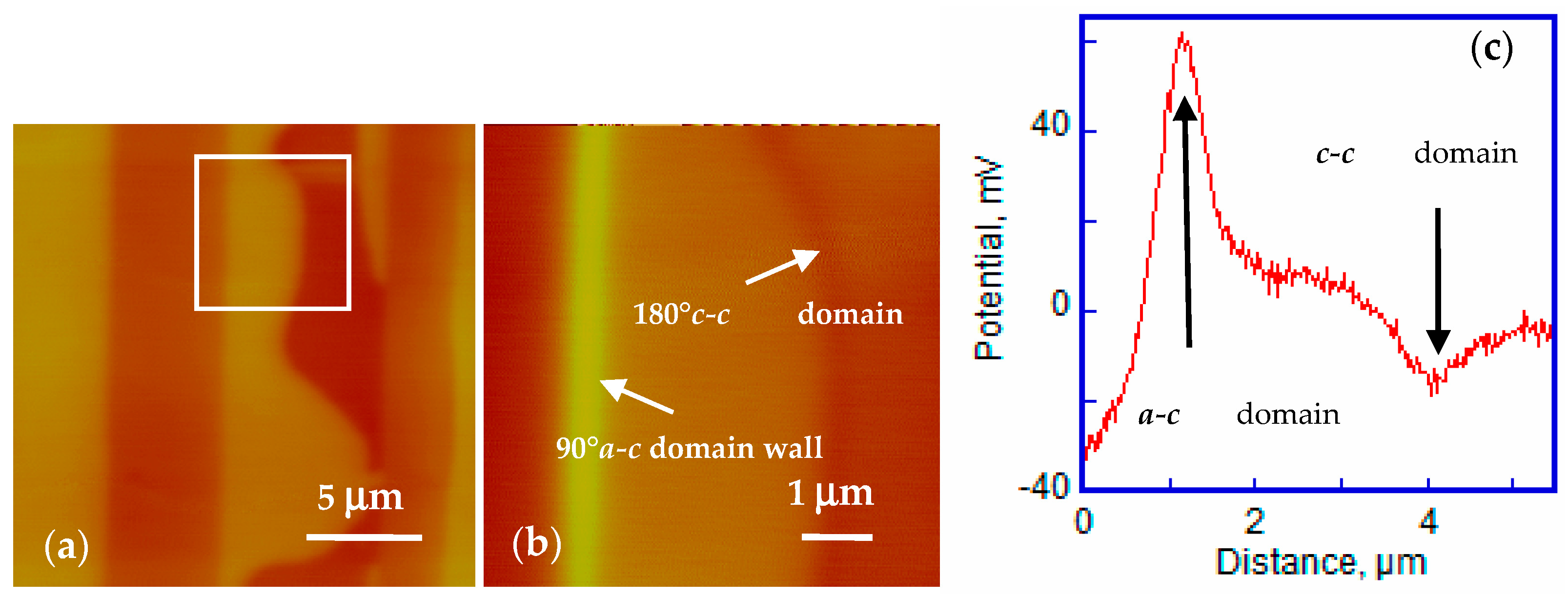
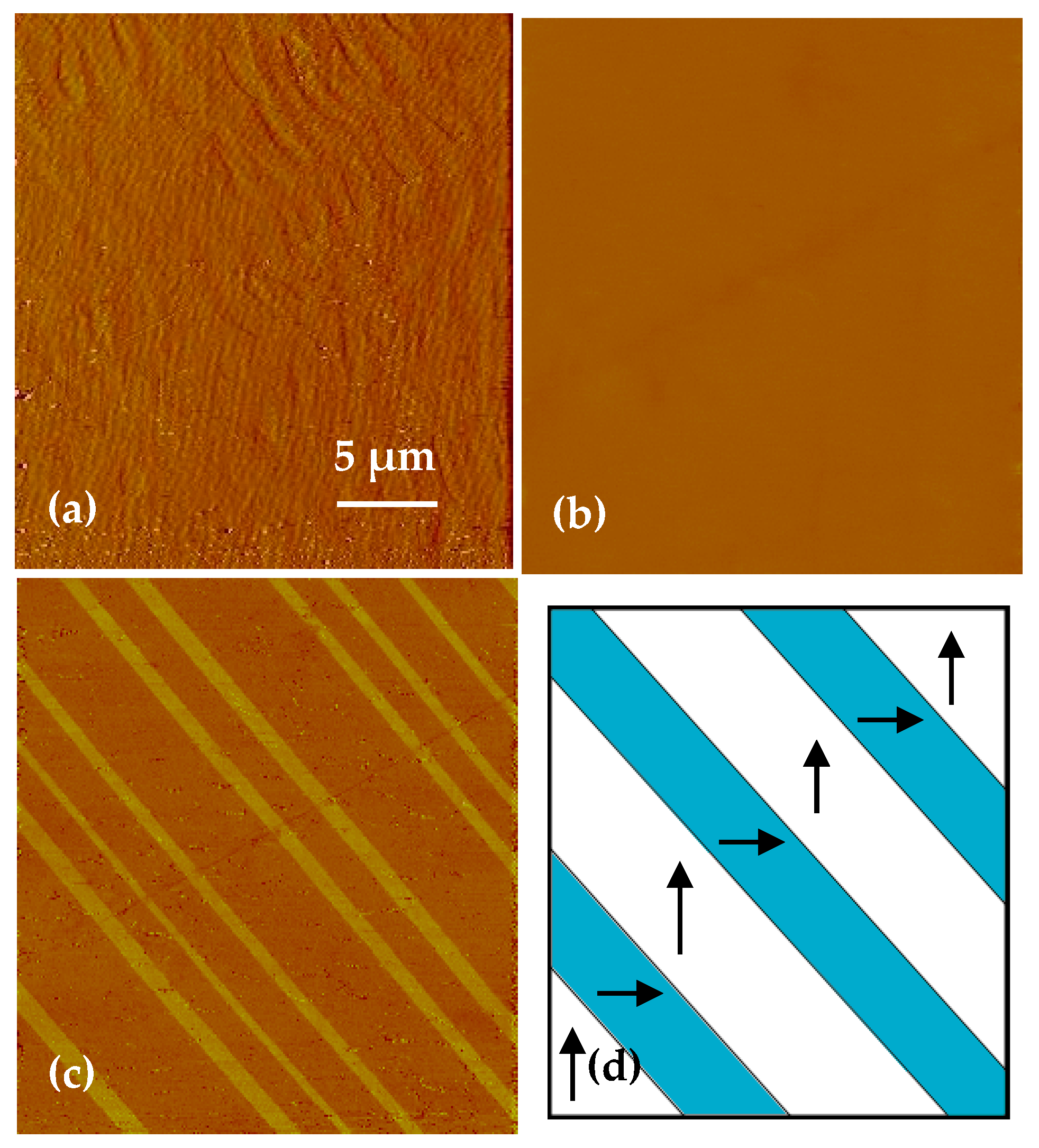

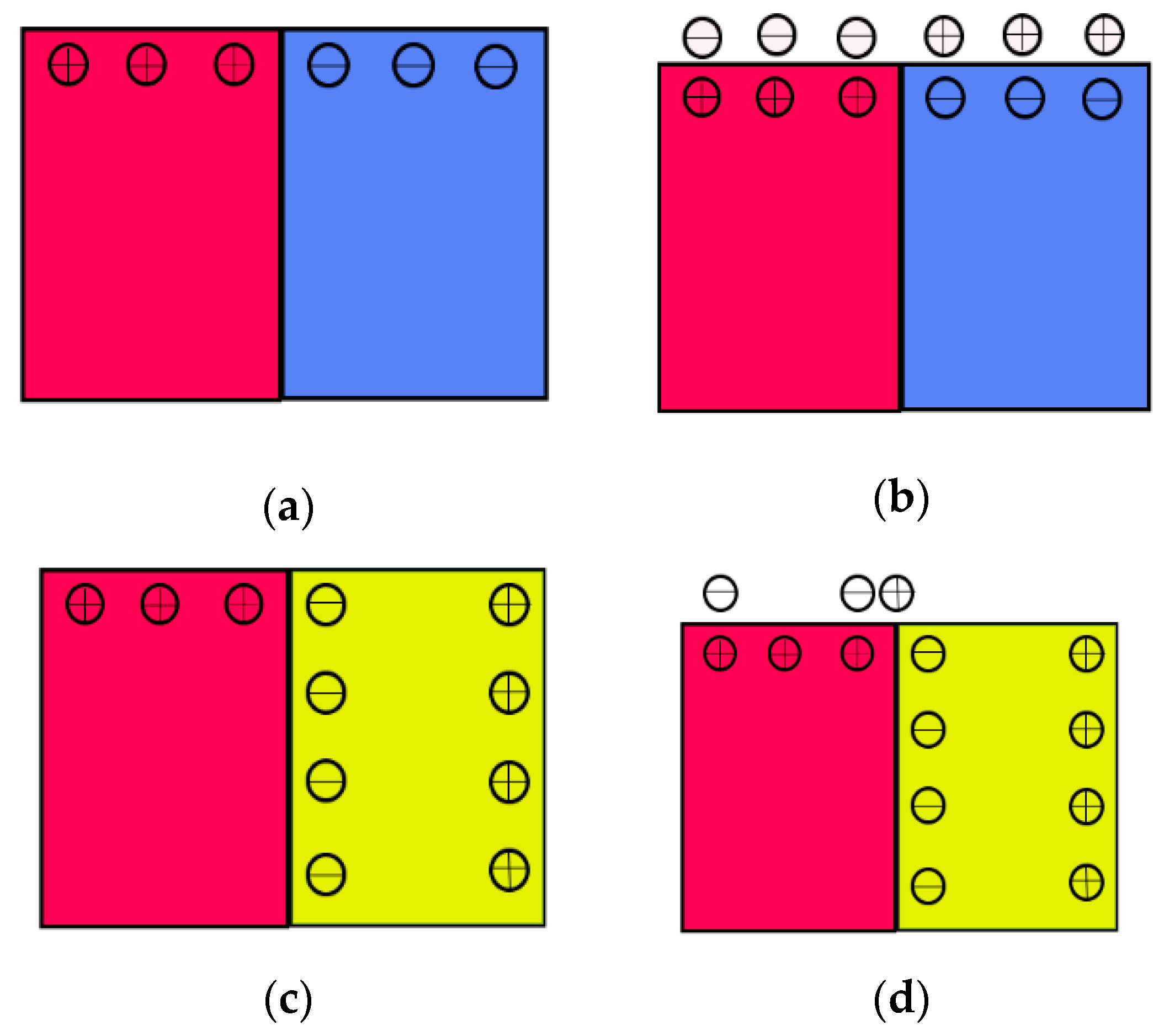
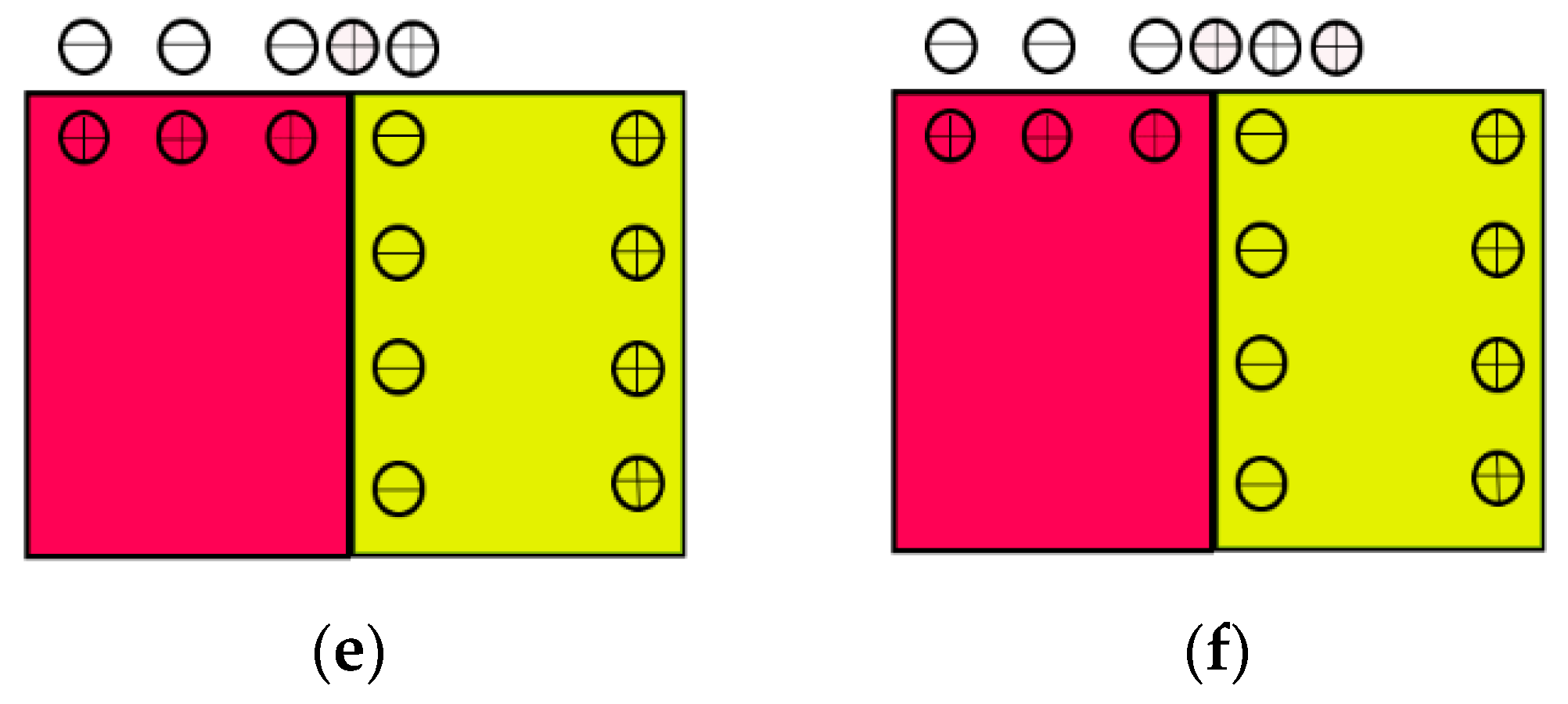
Publisher’s Note: MDPI stays neutral with regard to jurisdictional claims in published maps and institutional affiliations. |
© 2021 by the authors. Licensee MDPI, Basel, Switzerland. This article is an open access article distributed under the terms and conditions of the Creative Commons Attribution (CC BY) license (https://creativecommons.org/licenses/by/4.0/).
Share and Cite
He, D.; Tang, X.; Liu, Y.; Liu, J.; Du, W.; He, P.; Wang, H. Phase Transition Effect on Ferroelectric Domain Surface Charge Dynamics in BaTiO3 Single Crystal. Materials 2021, 14, 4463. https://doi.org/10.3390/ma14164463
He D, Tang X, Liu Y, Liu J, Du W, He P, Wang H. Phase Transition Effect on Ferroelectric Domain Surface Charge Dynamics in BaTiO3 Single Crystal. Materials. 2021; 14(16):4463. https://doi.org/10.3390/ma14164463
Chicago/Turabian StyleHe, Dongyu, Xiujian Tang, Yuxin Liu, Jian Liu, Wenbo Du, Pengfei He, and Haidou Wang. 2021. "Phase Transition Effect on Ferroelectric Domain Surface Charge Dynamics in BaTiO3 Single Crystal" Materials 14, no. 16: 4463. https://doi.org/10.3390/ma14164463
APA StyleHe, D., Tang, X., Liu, Y., Liu, J., Du, W., He, P., & Wang, H. (2021). Phase Transition Effect on Ferroelectric Domain Surface Charge Dynamics in BaTiO3 Single Crystal. Materials, 14(16), 4463. https://doi.org/10.3390/ma14164463





